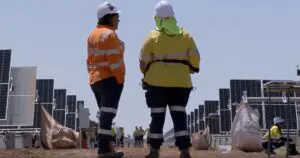The head of Australia’s Renewable Energy Agency (Arena) says he is more confident than ever about Australia’s ability to drive the cost of large scale solar down to a game-changing $20/MWh – thanks to developments in robotics and artificial intelligence.
Arena launched its 30-30-30 vision for ultra low cost solar in 2023. It aims to deliver 30 per cent module efficiency and a module cost of 30c/watt by 2030, helping to slash the current levellised cost of electricity from solar PV to below $20/MWh, one third of prevailing prices.
The target, along with the Solar Sunshot program that aims to boost Australia’s share of the global solar PV supply chain, and to foster local manufacturing, is considered crucial in delivering a low-cost renewable dominated grid, and the cheap power essential for Australia’s green hydrogen ambitions.
The Australian solar industry has seen the cost of PV modules, largely produced in China, fall significantly in the last two years, but some of these benefits have been offset by the increased cost of civil construction and labour.
Arena CEO Darren Miller, however, says the growing use of robotics and AI is offering opportunities to deliver the $20/MWh target.
“When we install solar in the field, we’d roughly be thinking of that costing about $1 a watt, fully installed,” Miller says in the latest episode of Renew Economy’s weekly Energy Insiders podcast.
“Obviously the modules are now only 20% to 30% of that number, but you’ve obviously got a huge amount of labor and civil works and electrical works to be done, and that adds up to, you know, roughly benchmarked at, say, $1 a watt.
“I’m actually much more confident, given the work that we’ve achieved with the industry over the last 12 months or so than probably I’ve ever been, that we can achieve that ($20/MWh) target from a levelised cost of energy perspective.
“It helps to have interest rates coming down, because, you know, a big part of getting getting a low LCOE is your financing structures and cost of capital, and that’s a separate matter, but we’re working on the capex, capex efficiency, if you like, the way you install solar in the field, at scale, at low cost.

“We have made great progress with robotics and machine learning in the field, different ways of piling, different ways of laying out modules in an automated fashion.
“And so I’m very confident that for Australian conditions, which are, you know, hot remote areas, that we will be able to deploy robotics and automation to help us achieve a much more efficient way of installing solar in our conditions. And that’ll help us drive towards that 30 cents.”
Renew Economy has written about some of those developments, such as the robotic mounting of solar panels in NSW, and installing pilings at a project in Victoria.
Miller says Arena’s $100 million solar challenge, essentially a call out for ideas to help lower the cost of solar projects, attracted 117 expressions of interest from 17 countries, and it has chosen the best dozen to potentially receive funding to trial their technologies in Australia. Some are expected to be announced soon.
Apart from module mounting and piling, Miller also has a vision for “factories in the field” to support the kind of huge solar arrays that will be essential for the decarbonisation of Australia’s economy.
“(This is) where you might set up a mini factory at your solar field, and you’ll have modules and steel coming in,” Miller says.
“And, in an ideal circumstance, you’d be rolling your torque tubes in the field and having an automated manufacturing line attached modules to these torque tubes and then taken out by autonomous vehicles into the solar farm.”
Federal climate and energy minister Chris Bowen, who harbours ambitions to have up to 20 per cent of Australia solar needs manufacturing in house, this week unveiled the first grant under the government’s $1 billion Solar Sunshot program, which like the Hydrogen Headstart program, is being managed by Arena.
That $46 million in funding when to solar innovator 5B, which has developed an unique system of readily deployable solar module systems that are currently best suited for remote and off-grid locations, but which may also be used for the next generation of giga-scale solar projects.
Miller says Arena has now committed $3 billion of fund to 780 different projects, and has another $7 billion to be distributed, with the big ticket items being Hydrogen Headstart and Solar Sunshot.
It is an extraordinary achievement, and the agency has been crucial in helping deliver the breakthroughs in large scale solar already achieved, providing key funding for the first large scale PV projects in the country.
Arena is also now focused on ground-breaking technologies essential for a modern renewable grid, including grid forming battery inverters, vehicle to grid technology, and various grid management schemes, particularly those focused on consumer energy resources.
Arena was formed in 2012 as part of the deal between the minority Labor government, The Greens and independents.
It has survived attempts to defund it from the Coalition government, and is now a crucial tool for the government seeking to replace Australia’s coal fired grid with a system dominated by renewables and storage.
You can listen to the full interview with Miller here, in the latest episode of Renew Economy’s weekly Energy Insiders podcast.








